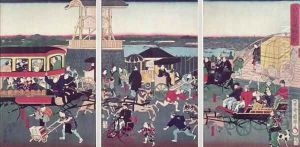Kuniteru II Utagawa Paintings
Kuniteru II Utagawa, born in 1829, was a distinguished Japanese ukiyo-e artist known for his contributions to the world of traditional Japanese woodblock printing. Part of the illustrious Utagawa school, Kuniteru II's works encompassed a variety of themes, including kabuki theatre, landscapes, and warrior prints, reflecting the rich cultural fabric of Edo-period Japan. He was not only a creator of beautiful images but also a chronicler of the changing times he lived in.
Kuniteru II initially studied under Kunisada I (Toyokuni III), one of the most prominent figures in the Utagawa school, who had a profound influence on his artistic development. Adopting the Utagawa name, Kuniteru II worked to carve out his distinct niche within the competitive world of ukiyo-e artists. His works are characterized by their vibrant colors, dynamic compositions, and attention to detail, showcasing his mastery over the traditional techniques of woodblock printing.
Throughout his career, Kuniteru II navigated the rapidly changing socio-political landscape of Japan, transitioning from the late Edo period into the Meiji Restoration. This period was marked by the opening of Japan to the West and the profound transformations that ensued within Japanese society. Kuniteru II's art captures this period of transition, reflecting both the traditional aspects of Japanese culture and the influence of Western art forms and ideas.
Despite his talent and contributions to Japanese art, Kuniteru II's work was often overshadowed by his contemporaries and the more famous artists of the Utagawa school. However, in recent years, there has been a growing appreciation for his art, with scholars and collectors recognizing the uniqueness of his vision and the quality of his craftsmanship.
Kuniteru II Utagawa's legacy is that of an artist who managed to bridge the traditional with the modern, encapsulating the complexities of his times through the medium of woodblock prints. He passed away in 1874, leaving behind a body of work that continues to be celebrated for its historical significance and artistic merit.
